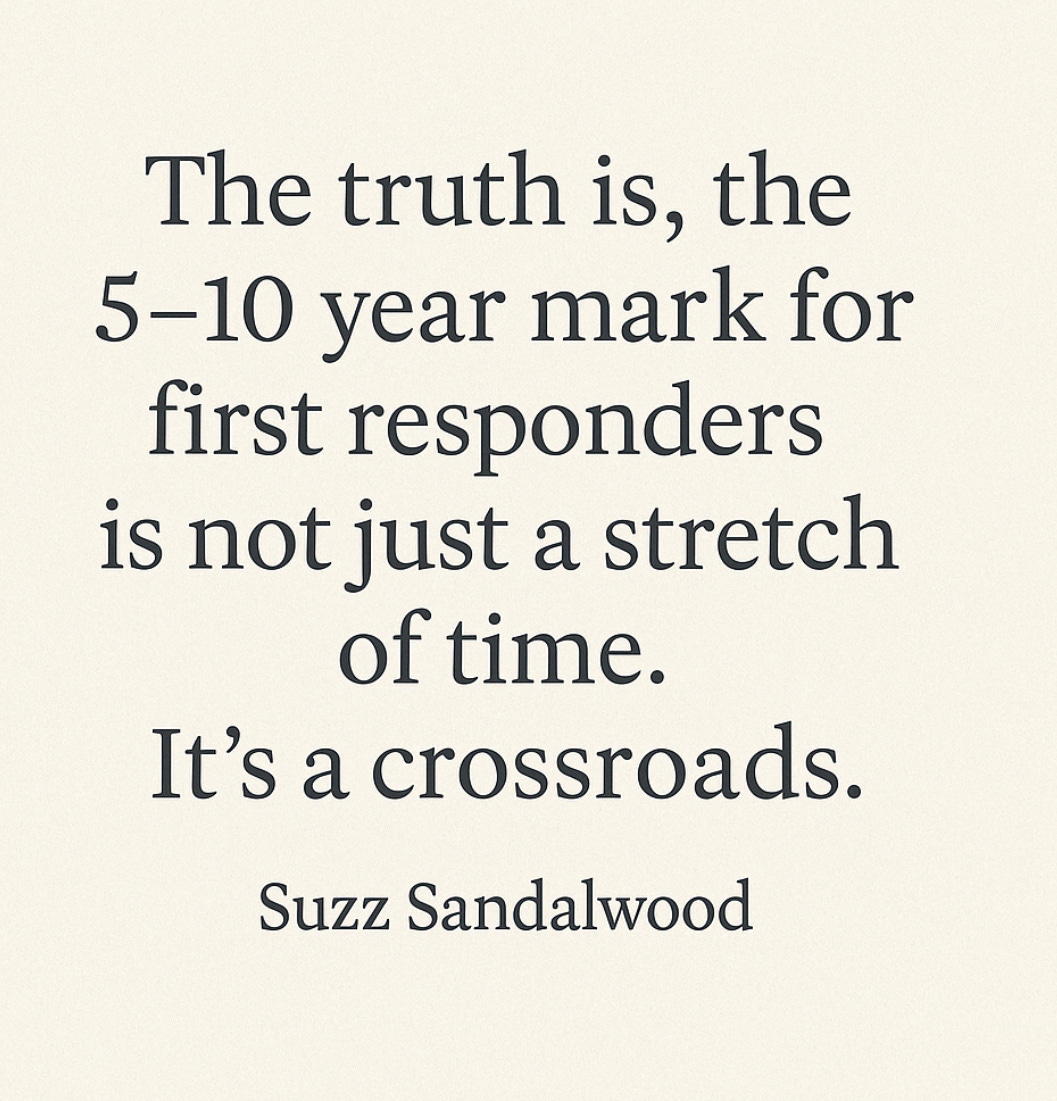The 5–10 Year Crossroads of First Responders
By Suzz Sandalwood | A closer look at the space between being a new recruit and seasoned veteran and why mental health professionals need to be aware of this timeline.
Written by Suzz Sandalwood | Seeking Veritas Columnist | Sankarsingh-Gonsalves Productions
The invisible shift- have you felt it?
…somewhere between years five and ten, something shifts. It’s not dramatic. It’s not even obvious to the outside world.
Early in the career, there’s momentum. Urgency. A constant influx of new experiences that demand full attention. The learning curve is steep. The decisions feel immediate. The work is intense, but it makes sense. There’s purpose in the pace.
Then, somewhere between years five and ten, something shifts. It’s not dramatic. It’s not even obvious to the outside world. But inside, many begin to feel it. A quiet dulling of response. A sense that the job isn’t changing, but they are.
These years are often overlooked by systems and culture alike. There’s no milestone attached, no space made for reflection. But ask around quietly, and the stories start to align.
Competent but numbing
By this stage, most first responders are sharp. They’ve built up technical skill and tactical instinct. But the emotional energy they once brought to the work can start to feel harder to access. The job gets done, but sometimes, it gets done on autopilot.
This isn’t a failure. It’s a form of adaptation. It’s what happens when exposure outpaces recovery for too long. When there’s no space to process what’s been absorbed, the body keeps going but the spirit withdraws. Not because they’ve stopped caring, but because they’ve run out of room to care safely. From the outside, everything still looks steady. But the internal landscape often tells a different story, one of fatigue that isn’t about rest, and distance that isn’t about disinterest.
The silence can be mistaken for resilience but it’s not resilience; it’s residue.
The misread silence
Clinicians unfamiliar with this landscape may not catch it. A responder in this phase won’t always present with acute symptoms. They may not talk about trauma at all. Instead, they might describe disconnection, irritability, low-level anxiety, or a sense that something is off but they can’t name what.
They may talk about their work in a flat tone. They may speak of their job and their relationships in the same emotionally neutral way. It’s not that they feel nothing, it’s that they’ve perhaps haven’t been able to figure out how to bring those feelings forward without consequence. The silence can be mistaken for resilience but it’s not resilience; it’s residue.
More than burnout
This stage is not burnout in the conventional sense. It’s not crisis. It’s not collapse. It’s a slow and quiet pulling away from the meaning of the work. It’s when responders start asking themselves if they’re still cut out for this, or if they’ve just become something else entirely. Some feel ashamed. Others feel like they’re just going through the motions but beneath the routine and regulation, something fundamental can sometimes bring forth the question, Is this still who I am?
An opportunity for integration
It takes skill to hold space for someone who isn’t falling apart but is quietly unravelling in slow motion.
When those questions surface in therapy, they are moments of opening, if the clinician can recognize them. These are not signs of pathology. They are signs of a person trying to stay human in a job that increasingly rewards disconnection. The challenge is to help them make sense of that dissonance without framing it as weakness.
It takes skill to hold space for someone who isn’t falling apart but is quietly unravelling in slow motion. To notice the moment when performance is no longer powered by purpose, but by habit. To help someone remember that it’s still possible to care, and still possible to protect their own emotional life in the process.
What we miss if we don’t ask
The truth is, most systems don’t check in at this stage. As long as people are doing the job, meeting targets, and not raising red flags, they are assumed to be fine. But this assumption misses something crucial. The emotional withdrawal that happens in the middle years isn’t just about exposure, it’s about the absence of integration.
Mental health professionals can be most effective by knowing to ask questions like “how do you feel about your job compared to when you first started?” While we have been focusing on general mental health and wellness of first responders and even new recruits, we have to realize that this time frame may need some extra care and attention. It’s not a diagnostic tool, it’s a doorway. This isn’t about catching a crisis. It’s about catching people in the in-between, when they’re still showing up, still functioning but starting to wonder if this is the job they really wanted and guiding them back to their why they wanted this job in the first place.
Next Week in the 911 Community Blog
“ Retired, But Not Released: When the Job Forgets You, But the Body Remembers. A Letter to Retired First Responders.
Retirement is supposed to be a finish line, but for many former first responders, it feels more like a quiet dismissal. The phone stops ringing. The camaraderie fades. The uniform comes off, but the hypervigilance stays. And while the system may forget them, their nervous systems don’t. Join me next week as I write about what happens when the job ends, but the impact doesn’t.
About the Author: Suzz Sandalwood is an RSW/MSW Therapist, Advanced Certified Clinical Trauma and Addiction Specialist and a Certified Grief Counsellor. She has extensive professional and personal experience in first responder, addiction, and grief communities. | Connect with the author: https://suzzsandalwood.com





